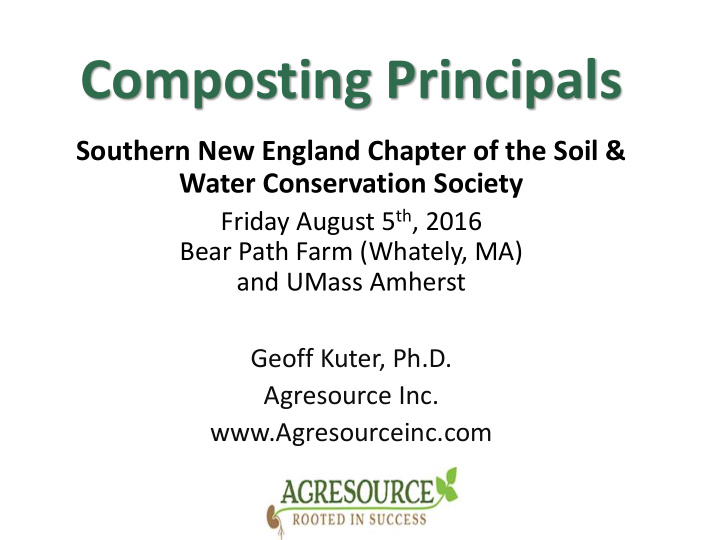



Composting Principals Southern New England Chapter of the Soil & Water Conservation Society Friday August 5 th , 2016 Bear Path Farm (Whately, MA) and UMass Amherst Geoff Kuter, Ph.D. Agresource Inc. www.Agresourceinc.com
Agresource Inc. Since 1984, providing organic waste management services to municipal and corporate clients • Land application of biosolids, wastewater and water treatment residuals from municipal and industrial sources. • Operation of regional composting facility in Ipswich MA • Compost marketing services for municipal and private facilities
Compost as the Product Compost vs. the Process: Composting • Composting is the process of recycling organic residues (wastes) into a product: Compost • Compost is more readily usable and has a higher value. • Convert raw organic matter to a more stable form, reduce pathogens and weed seeds.
What is Compost? Compost is a soil amendment that: • Provides organic matter • Supplies nutrients • Stimulates microbial activity Compost added to soil changes: • Soil physical properties • Soil chemistry • Microbial activity
Composting A process for converting and recycling “wastes” that includes: • Temperatures favoring the growth of thermophilic microbes (35 to 60 C or 105 to 160 F). • Under aerobic (the presence of oxygen) conditions. • Controlled process.
Putting organic matter in a pile and letting it decay is not composting
Composting Temperatures • Temperatures are high enough and for long enough time to kill pathogens and destroy weed seeds (55 C for 3 days). • Not too high as to slow microbial growth or generate fires.
Aerobic Conditions • Adequate oxygen to favor aerobic over anaerobic metabolism. • Carbon oxidized to carbon dioxide not organic acids or methane.
Aerobic Respiration
Composting Process Control Control temperatures (cool down piles) and provide oxygen by introducing air. • Turning piles. • Aerating piles (forced aeration) with blowers.
Different Ways to Make Compost
Composting Methods • Windrow Simplest approach with least process control and largest land requirement • Aerated Static Pile Moderately simple requirements for equipment and space with moderate level of process control • In-Vessel Typically mechanized with process control and containment and treatment of odors
Composting Steps • Preparation of the input mix • Active composting phase • Curing phase • Screening and product preparation • Compost storage
Composting • Adequate bulking agent to absorb moisture and insure pile has adequate porosity • Piles turned and mixed to insure exposure to microbial activity and break open particles and expose all portions to high temperatures.
Bulking Agent • Provides “structure” and porosity • Allows air movement • Source of carbon • Absorbs excess moisture
Air Filled Pore Space
Active Composting • High rate of microbial activity requiring oxygen to maintain aerobic conditions and aeration to cool piles • Aeration requirements dependent on rate of biodegradation and microbial activity • The amount of air needed to supply oxygen is less than that needed to remove heat and maintain temperatures • Active piles will have temperature gradients
Curing • Curing follows the active composting stage and allows time for further degradation of materials • Curing may not require forced aeration as degradation rates are lower • During curing temperatures may remain at thermophilic conditions • Curing may be associated with further drying
Screening • Large pieces of bulking agent may remain largely intact even after curing • Removal of both un-compostable debris and bulking agent using with ½ or ¾ inch screen improves acceptance of the product • Oversized pieces (screenings) can be recycled to supplement supplies of bulking agent • Screening can be performed prior to curing
Storage • Storage is required to account for the variability in demand for product • Compost in storage should be protected from run-off and run-on • Area should allow oldest material to be removed first • Prior to distribution from storage areas compost should be tested
Source Separated Food Wastes Food wastes received and mixed using front end loader with leaves.
Food Wastes Characteristics • High Moisture Content • Contaminated (Comingled) with Plastics • Highly Putrescible and Potentially Odorous
Contamination
Source Separated Food Wastes
Source Separated Food Wastes
Conclusions Multiple approaches to making compost Successful operations require: • Understanding and selecting appropriate feedstocks • Making the compost mixture • Managing the process to produce a consistent product
Recommend
More recommend